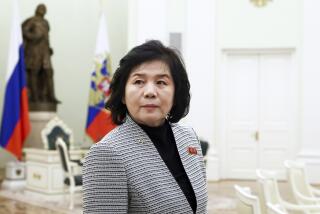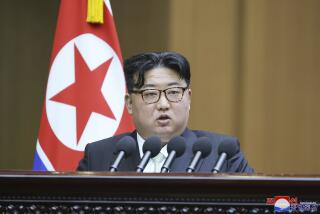North and South Korea agree: Their leaders will hold a summit on April 27 in the DMZ
Negotiators from North and South Korea set a date — April 27 — and a location in the demilitarized zone along their border for a summit between their two leaders, which could foreshadow a meeting between the North’s Kim Jong Un and President Trump.
The summit between Kim and the South’s president, Moon Jae-in, would be only the third top-level summit between the nations since an armistice ended hostilities in the Korean War in 1953 — and the first held on South Korea soil. The meeting location is the Peace House, a building just over the border on the south in the diplomatic outpost of Panmunjom, presenting the prospect of historic images showing Kim crossing the line.
But it remains unclear precisely how the negotiators, meeting Thursday, set the summit framework for any top-level discussion of the North’s nuclear and ballistic missile programs, seen as a key issue in any deal for long-term peace on the peninsula.
The negotiations over the date and location of the summit opened with a recent history lesson.
Cho Myoung-gyon, the South’s chief negotiator, reminded his counterparts from the North about talks in January over cooperation between the two Koreas at the Winter Olympics — dialogue that sparked the recent torrent of diplomatic activity that holds the promise of resolving decades of tension on the Korean peninsula.
“A journey of a thousand miles begins with a single step,” Cho, the South’s unification minister, recalled telling the group then and now. Those talks led to the last-minute participation of North Korean athletes in the Olympics, including as part of a unified Korean women’s hockey team.
Thursday’s deal represented another step, among many, in the recent thaw between the two countries. But plenty remain.
Experts watching the developments are mindful of how past agreements or potential diplomatic breakthroughs fell short.
Two key agreements in recent decades between Washington and Pyongyang over nuclear development eventually collapsed, and that work continued despite top-level talks between the North and South in 2000 and 2007 under previous leaders.
Kim Byoung-joo, who teaches foreign studies at Hankuk University in Seoul, said the United States and South Korea would seek to avoid the failings of previous agreements.
“This is a first step, but it’s not the same first step of the past, since it’s based on past experiences and lessons,” he said in reference to Cho’s opening remarks. “It’s a different kind of first step.”
The parties, who met on the North Korean side of the diplomatic complex to discuss the summit, plan to convene again early next month to discuss protocol, security and media coverage of the event, according to a joint statement.
South Korean officials said after the meeting that the summit would in principle focus on the North’s nuclear program, which sparked international condemnation last year over numerous ballistic missile tests and the underground detonation of a hydrogen bomb.
The North has boasted that it is now capable of striking the U.S. mainland with a nuclear-armed missile.
The parties also agreed that a peace agreement between the North and South, which are still technically at war, remained a goal.
“North and South agreed on the historical significance of the summit in denuclearization and settlement of peace on the Korean peninsula, and the improvement of inter-Korean relationship,” Cho said after the negotiations.
Ri Son Gwon, Cho’s counterpart on inter-Korean issues from the North, said “a number of working-level issues” remain before the summit next month.
“But if we acknowledge the historical significance and importance of the upcoming summit and make sincere efforts, we will be able to solve all problems promptly and smoothly,” said Ri, who helped negotiate the Olympics deal and traveled to the South during the Games.
Heather Nauert, the spokeswoman for the U.S. State Department, welcomed the announcement of the meeting. The summit “moves us closer to the point where the United States can sit down with North Korea and have a meeting.
“We’re realistic about that overall. The State Department is planning for that meeting. We’re going ahead in full faith and good faith.”
She said the Trump administration believes “overall that the pressure campaign is working.... We’re proud of that pressure campaign, and so many countries joining the United States in recognizing [these] destabilizing elements within North Korea and the North Korean regime, in terms of its ballistic missile and nuclear testing.”
As one result of the North Korea talks, Trump said he may put a hold on a new trade deal with South Korea that would lift U.S. steel tariffs in exchange for greater access to the South Korean auto market.
“I may hold it up until after a deal is made with North Korea,” Trump said during a speech in Ohio that was ostensibly about roads and bridges. “Because it’s a very strong card and I want to make sure everyone is treated fairly and we’re moving along very nicely with North Korea.”
The remarks surprised and confused many, because they appeared to draw a link between the trade deal with South Korea and the joint effort by the U.S. and South Korea to enter into talks with North Korea.
Trump agreed in early March to meet Kim, the totalitarian state’s third-generation leader, in May. The details for those potential talks remain unclear.
The agreement Thursday on the North-South summit details was an incremental step in a rapid diplomatic process that began with the election of Moon, who came to power in May promising a more dialogue-focused plan in dealing with the North after a decade of hard-line policies by previous South Korean presidents.
Last summer, Moon first floated the idea of a combined Korean hockey team at the Winter Olympics, held in February in Pyeongchang, South Korea.
It wasn’t until Kim’s own conciliatory speech on New Year’s Day that the idea gained traction.
After negotiations, the two nations fielded the joint team — the first truly Korean team in Olympics history — but also marched together during the opening ceremony under a neutral unification flag. The North sent numerous athletes and hundreds of others for cheerleading and cultural exchanges.
That then led to more dialogue and then the upcoming inter-Korean summit — and perhaps one with Trump, which would be a first for a sitting United States president and a North Korean leader.
The negotiations in Panmunjom came a day after revelations about the surprise trip Kim took to Beijing this week to meet with Chinese leader Xi Jinping.
The two countries, historically allies, have had a tense relationship in recent years amid the North’s nuclear provocations and international pressure on China to add teeth to economic sanctions.
It’s those sanctions that might have prompted Pyongyang to talk — or the fact that the nation feels comfortable that its nuclear development allows its leader to negotiate on the world stage in stronger position, said Kim Byoung-joo, the Hankuk University professor.
“Either way,” he said, “they have made a decision.”
ALSO
A velvet fist in an iron glove? China talks tough about Taiwan, but shows signs of a softer policy
Summits would expose North Korea’s Kim Jong Un to scrutiny he’s never experienced
With Xi in office for the long haul, China touts its stability — ‘the opposite of Washington, D.C.’
Stiles is a special correspondent.
UPDATES:
3:24 p.m.: This article has been updated with Trump administration reaction.
9 a.m, March 29.: This article was updated throughout with staff reporting, including additional details of the summit.
11:45 p.m, March 28.: This article was updated with additional details about the planned meeting, as well as context.
This article was originally published at Wednesday, March 28, at 11:15 p.m.
More to Read
Start your day right
Sign up for Essential California for news, features and recommendations from the L.A. Times and beyond in your inbox six days a week.
You may occasionally receive promotional content from the Los Angeles Times.







